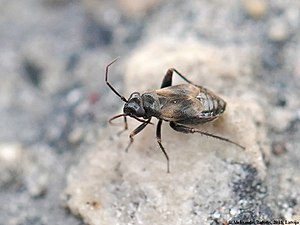Chlamydatus saltitans
| Chlamydatus saltitans | ||||||||||||
|---|---|---|---|---|---|---|---|---|---|---|---|---|

Chlamydatus saltitans |
||||||||||||
| Systematics | ||||||||||||
|
||||||||||||
| Scientific name | ||||||||||||
| Chlamydatus saltitans | ||||||||||||
| ( Fall , 1807) |
Chlamydatus saltitans is a species of bug from the family of soft bugs (Miridae).
features
The bugs are 2.1 to 2.6 millimeters long. Species of the genus Chlamydatus are almost completely black in color and have fairly broad thighs ( femora ) on the hind legs. They look similar to the species of the genus Halticus , but have longer antennae that are more than body length. The second antennae is shorter than the head is wide. In Chlamydatus saltitans , the glossy, pale-haired hemielytres are black with a brown base. The adult bugs almost always have shortened (brachyptere) hemielytres, which only reach about half the length of the abdomen. The hairs on the rails ( tibia ) of the hind legs do not arise from dark points. Fully winged (macroptere) animals appear but are rare.
Occurrence and habitat
The species is distributed throughout Europe excluding the southern Mediterranean and east to Siberia and the Caspian region. It is widespread in Germany and occasionally common locally. In Austria it occurs only in the Pannonian east and in the Alpine foothills and is not common.
They colonize dry and warm to hot, sandy and open habitats as well as salty areas inland.
Way of life
The bugs live on the ground between grasses and herbaceous plants and do not show any specialization in certain food plants. They are found mainly in Tüpfelfarngewächsen (Polypodiaceae), such as aviculare Polypodium , rarely on composite flowers (Asteraceae), legumes (Fabaceae) and cranesbill plants (Geraniaceae). However, they also feed predatory, sometimes even predominantly in this way. In Germany at least two generations are formed each year, in which the nymphs appear mainly in the first half of May and the second half of July. The adults can be observed from the second half of May and especially in June as well as in August and September, with females being found until October. The overwintering takes place as an egg.
supporting documents
Individual evidence
- ↑ a b c d e Ekkehard Wachmann , Albert Melber, Jürgen Deckert: Bugs. Volume 2: Cimicomorpha: Microphysidae (lichen bugs), Miridae (soft bugs) (= The animal world of Germany and the adjacent parts of the sea according to their characteristics and their way of life . 75th part). Goecke & Evers, Keltern 2006, ISBN 3-931374-57-2 , p. 220 .
- ↑ Chlamydatus saltitans. British Bugs, accessed January 3, 2015 .
literature
- Ekkehard Wachmann , Albert Melber, Jürgen Deckert: Bugs. Volume 2: Cimicomorpha: Microphysidae (lichen bugs), Miridae (soft bugs) (= The animal world of Germany and the adjacent parts of the sea according to their characteristics and their way of life . 75th part). Goecke & Evers, Keltern 2006, ISBN 3-931374-57-2 .
Web links
- Chlamydatus saltitans in Fauna Europaea. Retrieved January 3, 2015
- www.britishbugs.org.uk - photos, description